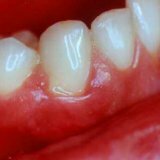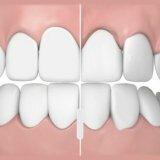Gum recession
 Gum recession is a non-inflammatory disease characterized by a decrease in the height and volume of the gums in the region of the tooth's neck, revealing the root. The cervix of the tooth is the place where the tooth crown moves to the root, its narrowest part. Normally below, the cervix is bounded by the marginal gum, which does not touch the tooth, but only touches it. At present, the number of patients who complain about hyperesthesia of teeth and roots has increased among the population. A common cause of this is the recession of the gums, which worsens the appearance of the teeth, gums, aesthetics of a smile. The gums look trimmed, especially if it is multiple lesions. Often, the dentin of the root is exposed( the roots of the teeth are not covered with enamel).Dentin has a light yellow hue; in some people it is slightly darker. This causes some discomfort in patients, especially in female patients. Since the dentin remains open, with non-compliance with hygiene, the early development of caries is possible. Dentinal tubules, which are the structural element of dentin, are in turn a tunnel to the pulp. The substitute dentin does not have time to be deposited in the pulp, thereby causing a risk of pulpitis.
Gum recession is a non-inflammatory disease characterized by a decrease in the height and volume of the gums in the region of the tooth's neck, revealing the root. The cervix of the tooth is the place where the tooth crown moves to the root, its narrowest part. Normally below, the cervix is bounded by the marginal gum, which does not touch the tooth, but only touches it. At present, the number of patients who complain about hyperesthesia of teeth and roots has increased among the population. A common cause of this is the recession of the gums, which worsens the appearance of the teeth, gums, aesthetics of a smile. The gums look trimmed, especially if it is multiple lesions. Often, the dentin of the root is exposed( the roots of the teeth are not covered with enamel).Dentin has a light yellow hue; in some people it is slightly darker. This causes some discomfort in patients, especially in female patients. Since the dentin remains open, with non-compliance with hygiene, the early development of caries is possible. Dentinal tubules, which are the structural element of dentin, are in turn a tunnel to the pulp. The substitute dentin does not have time to be deposited in the pulp, thereby causing a risk of pulpitis.
The prevalence of gum recession progresses with age. In young people the frequency of occurrence is 7-10%, in the period from 45 to 70 years is 85%, and in elderly people reaches 99%.In connection with the relative increase in the proportion of older people in society, the frequency of appeals in the future will increase. There is a large recession of gums in men, compared with women.
Allocate a localized and generalized gingival recession. The localized recession of the gum is the exposure of the neck and root of one tooth. The generalized recession of the gum is the exposure of the necks and root surfaces in a group of teeth on both the upper and lower jaws. A variant of the recession on both jaws is possible.
In connection with destructive changes in bone tissue, a quantitative shortage of soft tissues, the patient who has undergone treatment should come to the dentist's checkups every 6 months. The method of additional diagnosis will serve as an x-ray study, the results of which are more informative. The doctor will be able to accurately assess the condition of bone tissue and prevent repeated surgical intervention. The task of dental surgeons is to achieve the best long-term results of treatment for parodentologic patients. Their goal is to combine etiotropic therapy and surgical interventions. Depending on the condition and volume of the gum, the structure of the gingival papillae, the depth of the vestibule of the oral cavity, a method will be defined for treating gum recession.
The reasons for the recession of the gums
The reasons for the recession of the gums are very diverse: from congenital anatomical features, trauma, to age-related changes and periodontal inflammatory disease. Each person has an individual structure of the alveolar process of the jaw. It happens that teeth with strong and long roots have a thin layer of cortical plate, as a result of which the blood supply of this area is not fully realized, which causes the formation of a defect. Anomalies of the position of the teeth, the pathology of the occlusion also leads to the development of a gum recession. A small vestibule of the oral cavity( up to 5 mm.) Changes the ratio between the marginal and attached gum, disrupting the trophism of the mucous membrane. As for the gum trauma, they are acute and chronic. Permanent injuries include bad habits( biting nails and pens), applying a hard toothbrush, rough teeth cleaning, sharp edges of seals, inadequate prostheses, traumas when doing sports.
Plaque plays an important role in the development of gum recession. The conglomeration of microorganisms and food residues leads to the formation of gingivitis and the displacement of the gum margin. Dental deposits provoke the development of periodontitis, which is the cause of the ailment. When treating with orthodontic devices, it is possible to increase the strength of the movement of teeth, which can lead to thinning of the gums. Inadequate oral hygiene in the treatment of the braces system is an auxiliary factor in this pathology. Iatrogenic pathology - this concept is associated with such negligent actions of the doctor as the leakage of arsenous paste on the gum, which subsequently causes necrosis of soft tissues, mucous membranes and bone tissue of the alveolar process of the jaws with further development of the recession.
There may be a recession after mechanical injury of the gum with burs during the formation of the carious cavity, during the final processing of the filling( grinding, polishing) by the dentist, leaving uneven edges of the crowns and seals.
As a result of inadequate endodontic treatment, there are consequences such as root fracture and perforation. In the future, this can cause the formation of chronic destructive processes in the apical tissues. Resorption of bone tissue is accelerated by perforation of the anterior surface of the root, a recession of the root occurs and a fistula appears. Gum recession may be the first symptom in the vestibular perforation of the root.
Symptoms and signs of recession of the gums
In the initial period, the recession of the gum does not differ markedly by symptoms. Expressed a decrease in gingiva, patients notice with a significant recession. Painful sensations arise at the stage of exposure of the root of the tooth. Changing temperatures( sucking in cold air), eating sweet, sour, salty foods, as well as chewing on coarse and hard foods, cause an unpleasant sensation. At the dental appointment, the doctor can detect tooth decay of the root. If the defect is located on the front teeth, the patients will complain about the aesthetic defect, which is visualized with a smile.
The variety of types of gum recession entails a variety of symptoms.
Traumatic gum recession occurs more often at a young age, frequent location - upper incisors, canines and premolars. Its size is 3 mm. Possible cushion-shaped thickening of the gum, no inflammation, plaque in a moderate amount, sensitivity increased.
Symptomatic recession of the gum caused by inflammatory diseases of the paradontium, consists of dental deposits, bleeding gums, teeth mobility, the presence of periodontal pockets, multiple recession of gums on various surfaces of the teeth.
The physiological recession of the gum is related to the patient's age. Usually it's people over 60 years old. The recession in this case is observed on both jaws, it is pronounced, there is no inflammation, the teeth are stable, immovable.
Treatment of gum recession
Treatment of gum recession must first of all be complex, that is, eliminate etiological, pathological and symptomatic causes. These include: elimination of bad habits, therapeutic sanitation of the oral cavity, correction of malocclusion, protection of teeth with mouthguards when practicing sports, maintaining oral hygiene in a satisfactory condition( professional hygiene of the mouth with a hygienist once every six months).Elimination of gum recession can be carried out at the stages of prevention on examinations with a dentist. If the right treatment is not made in time, the recession can lead to serious consequences: the development of inflammatory phenomena in the tissues of the gums and the mobility of the teeth, until their complete loss.
Patients are asking themselves: what are the ways to eliminate such an aesthetic and physiological defect as a gum recession? Before planning further treatment, it is necessary to inform the patient about the need for X-ray examination of the organs of the dento-jaw system. In particular, it is possible to offer an orthotantomogram or computed tomography. Devices for computed tomography are not available to all dental offices and clinics. This method is expensive and not all budget patients will agree to undergo computer research. An alternative and less expensive study is an orthopantomogram. This method is also informative, the doctor will be able to make a complete plan for treatment, make a financial plan for the patient. The result of this study remains in the patient's hands and it will be needed by specialists of other profiles, if suddenly the patient wants to continue prosthetics with a dentist orthopedist.
There are many modern methods of treatment. Physicians are offered medication and surgery. Surgical treatment is aimed at resuming the gingival margin and overlapping the bare root. Elimination of the recession of the gum depends on the age of the patient, as well as the causes and characteristics of the pathology.
Surgery for gum recession: use of a lateral flap, movement of the gingival flap, transplantation of a tissue flap from the hard palate, directed tissue regeneration. Closure of gum recession is carried out 7-10 days after the implementation of mandatory occupational oral hygiene. Closure of the gum recession with the use of a lateral flap( also called a "flap on the leg") is used in a single recession with a sufficient number of gum tissues. At the very beginning of the operation, infiltration anesthesia is performed, two parallel incisions are made, the submucosa is separated, a flap is formed. Mechanical and medicament treatment of the root surface is carried out, then the flap is fixed with catgut sutures. The plasticity of the recession of the gum with this method gives very good results, the correspondence of the tissues to the color achieves an aesthetic optimum.
The movement of the gingival trapezoidal flap to the defect area has a number of limitations - the gum volume should be large. It is possible to eliminate the recession of the gums both in generalized and localized form. The results of treatment are quite good.
A tissue graft transplant was introduced into the practice of a dentist long enough. The gingival autograft is created from the mucosa of the hard palate. The flap is moved to the place of the bare root, fixed, thereby eliminating the defect. The disadvantages of this technique are unpleasant sensations in the area of the wound surface of the hard palate and discrepancy of the color of the regenerate with the tissues of the gum.
The modern method of plastic surgery for gum recession is the method of directed tissue regeneration, created to activate tissue cells multiplication, using resorbable and non-resorbable separation membranes. Directed regeneration makes it possible to restore the damaged periodontal structure. The use of non-resorbable membranes requires an additional operation to remove it. Non-resorbable membranes have a rigid framework and do not adapt to the underlying tissues, as resorbable. The hardness of the membranes can promote its opening, which leads to contamination by microorganisms with possible rejection. The use of resorbable membranes eliminates the need for a second operation to remove them. The effectiveness of resorbed membranes in comparison with non-resorbable membranes is approximately 8% lower. Surgery for gum recession according to statistics gives good results: 83% of patients are satisfied with the result of treatment.
Drug treatment shows good results, achieving an absolute regeneration of periodontal structures. The protein components of the enamel matrix appear in the tissues before the beginning and are present during the whole period of the maturation of the cement.
The basis of proteins is a substance such as amelogenin, which takes part in the maturation of enamel and the formation of the root of the tooth. Mesenchymal cells of the rudiment of the tooth act on the enamel base, forming on the surface of the enamel cell-free cement.
If patients are focused on the cost of treatment, have contraindications to the operation, there is an allergy to the components of the drugs, another way of eliminating the recession of the gums is possible. The exposed root of the tooth is covered with a seal of composite material, matched to the color of the gingival tissue. This method is little effective and not long-term, but it has a place to be. The positive side of the method is the elimination of an aesthetic defect.



